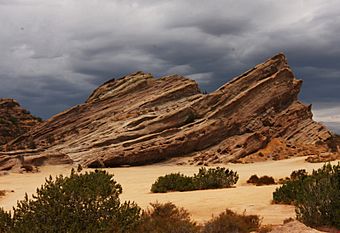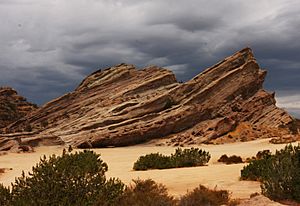Vasquez Rocks facts for kids
Quick facts for kids |
|
|
Vasquez Rocks
|
|

Vasquez Rocks
|
|
| Lua error in Module:Location_map at line 420: attempt to index field 'wikibase' (a nil value). | |
| Location | Escondido Canyon Rd., Agua Dulce, California 91390 |
|---|---|
| Nearest city | Agua Dulce, California |
| NRHP reference No. | 72000228 |
| Added to NRHP | June 22, 1972 |
Vasquez Rocks Natural Area Park is a huge park covering about 932 acres (377 hectares) in northern Los Angeles County, California. It's famous for its amazing rock formations. These rocks were shaped by layers of sediment and later pushed up by earthquakes. The park is near the town of Agua Dulce, between the cities of Santa Clarita and Palmdale. You can even see the rocks from the Antelope Valley Freeway (State Route 14). Because of their unique look, Vasquez Rocks has been a popular spot for filming movies and TV shows many times!
Contents
History of Vasquez Rocks
The unique rock formations at Vasquez Rocks were created by fast erosion and powerful geological forces. About 25 million years ago, the land was pushed up, and then later, more movement along the San Andreas Fault exposed these incredible rocks.
Long ago, the Tataviam people lived here. They spoke a language related to Uto-Aztecan languages. They lived in villages with grass huts. When the Spanish arrived, some Tataviam people were forced to work at the Spanish missions. Over time, they started speaking Spanish and married people from other tribes. The last known Tataviam person passed away in 1916.
In 1874, a famous California outlaw named Tiburcio Vásquez used these rocks to hide from the police. That's how the rocks got their name!
Los Angeles County slowly bought the land and rock formations. It started with a gift of 40 acres in 1971, and more land was added until 2001. The Pacific Crest Trail, a very long hiking trail, goes right through the park.
Vasquez Rocks was added to the National Register of Historic Places in 1972. This was because it's a very important ancient site for the Shoshone and Tataviam peoples.
How Vasquez Rocks Formed
The rocks you see at Vasquez Rocks are part of something called the Vasquez Formation. Scientists believe the first layers of sediment were laid down between 33.9 and 5.3 million years ago.
The Vasquez Formation is located just east of Santa Clarita, California. It sits in a valley called the Soledad Basin. This basin is between the Sierra Pelona Mountains to the northwest and the San Gabriel Mountains to the east. These mountains are part of Southern California's Transverse Mountain Range. The famous San Andreas Fault runs behind the Sierra Pelona Mountains.
The Vasquez Formation is made of sediments that washed down from the Sierra Pelona and San Gabriel Mountains. These sediments were carried by rain, floods, wind, and even earthquakes. Over millions of years, these layers of sediment built up. They were laid down in changing conditions, sometimes in lakes and sometimes in rivers. Huge pressure turned these layers into sandstone. More sediment then covered these sandstone layers.
Because Vasquez Rocks is close to the San Andreas Fault, earthquakes and other ground movements have greatly shaped the area. These movements pushed up and exposed the buried sandstone. The Elkhorn Fault, which is a branch of the San Andreas Fault, runs right through Vasquez Rocks Natural Area Park. Other faults nearby include the Pelona, Vasquez Canyon, Soledad, and San Gabriel Faults.
The rocks at Vasquez Rocks are mostly made of coarse-grained conglomerate and breccia. These are types of rock formed from large, broken pieces of other rocks. They were deposited next to active faults when the San Gabriel Mountains were quickly pushed up and eroded. About 25 million years ago, the North American Plate and Pacific tectonic plates collided. This collision pushed up the land along the Elkhorn Fault.
Strong erosion from the highlands, along with more uplift and volcanism, caused rock and mud to flow into a fast-sinking valley called the Soledad Basin. These sediments were buried and turned into rock over millions of years. More recently, activity along the San Andreas Fault system exposed them. The rock layers are now tilted sharply and look very dramatic. You can clearly see how different the sizes of the rock pieces are between the layers. In the upper layers of these rocks, scientists have found fossils of ancient animals like camels, horses, and rodents!
Vasquez Rocks in Movies and TV
Vasquez Rocks is a very popular place for filming! Its unique look makes it perfect for many different scenes.
- In 1935, Universal Studios used Vasquez Rocks to look like Tibet for the movie Werewolf of London.
- The famous rock formation appeared in several episodes of the original Star Trek TV show. It was also seen in the movie Star Trek V: The Final Frontier and an episode of Star Trek: Picard.
- Many other feature films have been shot here, including Bill & Ted's Bogus Journey, Dante's Peak, The Flintstones, Blazing Saddles, and Paul.
- TV shows like Zorro, The A-Team, and MacGyver have also filmed scenes at the rocks.
- Even commercials for big companies like Taco Bell and Nike have used Vasquez Rocks.
- Musicians like Radiohead, Michael Jackson, and BTS have filmed their music videos here too!
Fun Activities at Vasquez Rocks
Vasquez Rocks Natural Area Park is open from sunrise to sunset, and there are lots of fun things to do!
- You can go horseback riding in the equestrian areas.
- There are nice picnic areas where you can enjoy a meal outdoors.
- The park has many hiking trails, perfect for exploring the unique landscape.
- If you like adventure, you can even go rock climbing on some of the formations.
- The Pacific Crest Trail goes through the park, offering both short walks and longer hikes.
- The park also hosts special events, like Star Parties where you can look at the night sky, and even weddings!


